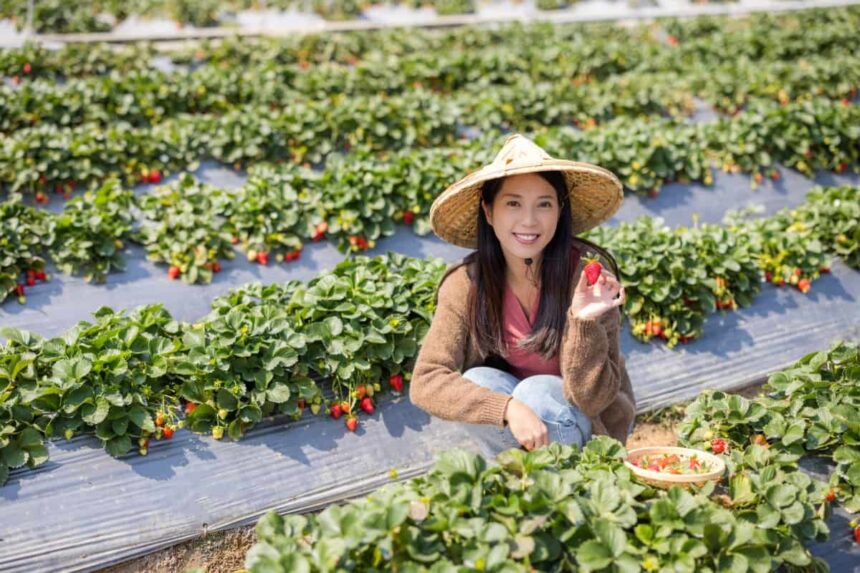Strawberry is a member of the Rosaceae family, and its scientific name is Fragaria x ananassa. Strawberry farming is significant in agriculture and the economy. These berries are not only delicious but also packed with nutrients, and they play a vital role in promoting healthy eating habits. Strawberry plants are herbaceous perennials, meaning they grow back year after year. These berries thrive in varied climates, making them a popular choice among gardeners.

Soil Preparation and Fertility Management
Soil preparation is the cornerstone of successful Strawberry farming. A well-prepared bed ensures that plants have the nutrients they need to thrive. Start with a soil test to find pH levels and nutrient levels. Strawberries prefer slightly acidic soil, ideally between 5.5 and 6.8 pH. Amend your soil accordingly by adding lime or sulfur as needed.
Incorporating organic matter enhances fertility and improves structure. Aged manure can provide essential nutrients while promoting beneficial microbial activity. Proper tilling creates a loose, aerated environment for root development. Consider crop rotation strategies to minimize nutrient depletion and disrupt pest cycles. Healthy soil not only supports robust plants but also leads to higher yields in every season.
Watering Issues: Overwatering vs. Underwatering
Watering Strawberries can be tricky. Too much or too little can lead to serious problems. Overwatering is a common mistake. It suffocates roots and causes rot. Plants become vulnerable to diseases, leading to loss of yield. Signs include yellowing leaves and wilting plants despite wet soil. On the other side, underwatering stunts growth and affects fruit quality. Strawberries need consistent moisture, especially during flowering and fruit development.
Dry conditions result in smaller berries that lack flavor. Monitoring soil moisture is essential for healthy Strawberry plants. A simple finger test can help; if the top inch feels dry, it’s time to water again. Drip irrigation systems are excellent options for maintaining optimal moisture levels while minimizing waste. Finding the right balance ensures vibrant plants are ready for harvest without compromising their health or productivity.
Pest Control: Managing Common Strawberry Pests
Strawberry farming comes with several challenges, and pests are among the most notorious. Keeping these uninvited guests at bay is crucial for a healthy crop. Aphids can be particularly problematic. These tiny insects suck sap from plants, leading to stunted growth and reduced yields. Then there are spider mites, which thrive in hot, dry conditions. Their webbing can smother Strawberry plants if left unchecked.
In case you missed it: Strawberry Nursery Establishment and Management

Slugs and snails also love Strawberries as much as we do. They tend to feast on young leaves and ripe fruit during damp nights. Don’t overlook the threat posed by thrips, either. They damage flowers and fruits, causing scarring that affects their marketability. Effective pest control strategies involve regular monitoring and integrated approaches combining biological controls with organic pesticides when necessary to keep your Strawberries thriving without harm.
Disease Prevention and Treatment
Strawberry plants are affected by a variety of diseases that can significantly impact yield. Early recognition of these threats is crucial for effective management. The common disease is powdery mildew, characterized by white, powdery spots on leaves. This fungal infection thrives in warm conditions with high humidity. Another concern is botrytis fruit rot, which causes gray mold on ripe Strawberries. This often occurs during wet weather and can spread rapidly if not addressed promptly.
Fusarium wilt attacks the plant’s vascular system, leading to wilting and yellowing foliage. Unfortunately, once infected, plants may need to be removed entirely to prevent further spread. Alternaria leaf spot manifests as dark lesions on leaves and can reduce photosynthesis efficiency. Regular monitoring helps catch these issues before they escalate. When diseases do appear, timely fungicide applications may help mitigate damage effectively.
Frost Protection and Temperature Management
Frost can wreak havoc on Strawberry crops, especially during critical growth phases. Protecting Strawberries from unexpected temperature drops is vital for a successful harvest. The effective strategy is to use row covers. These lightweight fabrics trap heat and create a microclimate around the plants. This method not only shields them from frost but also provides some shade during hot days.
Another technique involves using water irrigation just before temperatures dip. When water freezes, it releases heat, creating a protective barrier against frost damage. Monitoring weather forecasts also plays a crucial role. By staying informed about impending cold snaps, farmers can take timely action to safeguard their crops.
Weed Management in Strawberry Fields
Weeds can be a significant challenge in Strawberry farming, competing for nutrients and water. Effective management is essential to ensure healthy plants and high yields. Mulching is one of the most effective methods. Organic mulches not only suppress weeds but also improve soil moisture retention. Another important strategy involves regular hand weeding. Though labor-intensive, it allows farmers to precisely target unwanted plants without disturbing the Strawberries.
In case you missed it: How to Control Pests and Diseases in Strawberry Crop: Causes, Symptoms, Chemical, and Biological Management

Herbicides can also play a role, particularly pre-emergent types that prevent weed seeds from germinating. However, careful application is crucial to avoid harming Strawberry plants. Crop rotation adds another layer of defense against persistent weeds by disrupting their growth cycles. Additionally, planting cover crops during off-seasons helps maintain soil health while minimizing weed establishment.
Pollination Problems and Solutions
Weeds can be a significant challenge in Strawberry farming, competing for nutrients and water. Effective management is essential to ensure healthy plants and high yields. Mulching is one of the most effective methods. Another important strategy involves regular hand weeding. Though labor-intensive, it allows farmers to precisely target unwanted plants without disturbing the Strawberries.
Herbicides can also play a role, particularly pre-emergent types that prevent weed seeds from germinating. However, careful application is crucial to avoid harming Strawberry plants. Crop rotation adds another layer of defense against persistent weeds by disrupting their growth cycles. Additionally, planting cover crops during off-seasons helps maintain soil health while minimizing weed establishment.
Soil pH and Nutrient Deficiencies
Soil pH plays a critical role in Strawberry farming. It influences nutrient availability, affecting how plants absorb essential minerals. Strawberries thrive best in slightly acidic soil. When the pH deviates from this range, nutrient deficiencies can arise. For instance, if the soil is too alkaline, iron and manganese become less available. This leads to symptoms like yellowing leaves or stunted growth.
Regular soil testing is key for monitoring pH levels and nutrient status. In addition to managing pH, it’s vital to ensure an adequate supply of nutrients like nitrogen, phosphorus, and potassium. Using organic amendments such as compost not only enriches the soil but also contributes beneficial microorganisms that support plant health.
Mulching Techniques for Optimal Growth
Mulching is a crucial technique for Strawberry farmers who want to optimize growth. It involves covering the soil with synthetic materials to create a protective layer. One popular option is Straw mulch. It helps to suppress weed growth, providing an ideal environment for Strawberries. Plus, it gradually enriches the soil as it decomposes.
In case you missed it: How this Farmer Earning 18 Lakhs from His Strawberry Farm: A Success Story of a Fruit Farmer in India

Plastic mulch has also gained traction. Available in various colors, it warms the soil and enhances fruit production by controlling temperature fluctuations. Black plastic is particularly effective at keeping weeds at bay while reflecting sunlight onto plants. Organic alternatives like wood chips or shredded leaves also offer benefits. They improve soil structure over time and promote beneficial organisms that support plant health.
Harvesting Challenges: Timing and Techniques
Harvesting Strawberries at the right time is crucial for quality and flavor. Picking too early results in sour berries, while waiting too long can lead to overripening and spoilage. Growers must keep a close eye on their fields. Techniques vary widely. Hand-picking remains the gold standard, allowing careful selection of ripe fruit.
However, using machines can speed up the process during peak harvest times. Each method has its pros and cons. Weather conditions also significantly influence harvesting strategies. Rain or high humidity can increase the mold on freshly picked berries, making timing even more critical.
Post-Harvest Handling and Storage Issues
Post-harvest handling is a critical phase in Strawberry farming. Once harvested, Strawberries are highly perishable and require immediate attention. Proper cooling techniques can significantly extend their shelf life. Rapidly lowering the temperature helps maintain freshness and flavor. However, if handled poorly, these delicate fruits may suffer from bruising or decay.
Storage conditions also play a vital role. Humidity levels should be monitored closely to prevent mold growth and avoid excessive dryness, which can cause dehydration. Packaging matters, too. Using breathable containers allows air circulation without trapping moisture inside, keeping Strawberries looking appealing to consumers. Farmers must also be aware of transportation challenges. Long distances can lead to quality loss if not managed effectively. Ensuring quick transit times will help preserve the fruit’s integrity until it reaches market shelves.
Market Fluctuations and Price Volatility
During peak seasons, an abundance of Strawberries can lead to lower prices. Conversely, bad weather or pest infestations can shrink yields and drive costs up. This unpredictability makes planning difficult for growers. Additionally, the rise of global markets means that Strawberries aren’t just competing locally anymore. Farmers now face price competition from international producers who may offer their products at lower rates.
In case you missed it: Growing Strawberries Vertically from Scratch: Methods, Tips, and Ideas

Farmers must stay informed about market trends and adjust their strategies accordingly. Building strong relationships with distributors can help secure better pricing amid volatility. Understanding these challenges is essential to thrive in the ever-changing landscape of Strawberry farming. Adapting marketing strategies becomes essential during such times. Building relationships with local markets or diversifying product offerings may help stabilize income in uncertain conditions. Understanding market trends is crucial for long-term success in Strawberry farming.
Transportation and Distribution Challenges
Once harvested, Strawberries have a short shelf life that demands swift action. Farmers face logistical hurdles in getting their fresh produce to market quickly. Delays can lead to spoilage, which significantly impacts profits. Strawberries’ delicate nature requires careful handling during transit. Choosing the right transportation methods is vital. Refrigerated trucks help maintain freshness but come with high operational costs. Balancing efficiency with affordability becomes a challenging task for many growers.
Additionally, distribution networks must be well-coordinated. Farmers often rely on intermediaries who might not prioritize speed or care in handling the fruit. This disconnect can result in damaged goods reaching retailers or consumers. Weather conditions also affect road accessibility and delivery schedules. Navigating these challenges requires strategic planning and innovative solutions from farmers who want to get their berries into eager hands efficiently.
Farmers often face logistical hurdles like inadequate transportation infrastructure. Rural areas may lack reliable roads or access to refrigerated transport. This not only increases costs but also affects product quality upon reaching consumers. Additionally, the timing of deliveries is a persistent challenge. Strawberries have a short shelf life, demanding precise scheduling from farm to market. Any misstep can compromise their appeal. Weather conditions further complicate matters. Rainstorms or extreme heat can disrupt transport schedules and affect the overall supply chain efficiency.
Labor Shortages and Workforce Management
Many growers face difficulties attracting and retaining skilled workers during peak seasons. The seasonal nature of the work can deter potential employees. Additionally, competition from other industries often leads to fewer hands available for harvesting and planting. Effective workforce management becomes crucial to address these challenges. Offering competitive wages and benefits can incentivize individuals to join the team.
In case you missed it: Growing Strawberries In Greenhouse – In India

Training programs play a major role in equipping workers with the necessary skills. Investing in employee development fosters loyalty and enhances productivity. Flexibility in scheduling may also attract more candidates. Understanding that many job seekers seek a balance between work and personal life can make an operation more appealing. Collaboration with local schools or vocational training centers might help create a pipeline of interested workers ready to enter the field. This proactive approach is essential for securing a reliable labor force.
Climate Change Impact on Strawberry Farming
Rising temperatures can alter flowering and fruiting times, impacting yields. Farmers often find themselves grappling with unpredictable weather patterns. Increased rainfall can lead to waterlogged soil, affecting root health and making plants more susceptible to diseases. Conversely, drought conditions can stress plants, reducing fruit size and flavor quality.
Moreover, pests typically thrive in warmer climates. This creates an added layer of complexity as farmers must adapt their pest management strategies continuously. To combat these issues, growers are exploring innovative practices such as climate-resilient varieties and advanced irrigation techniques. These methods aim to enhance resilience against the shifting environmental landscape while ensuring that Strawberries remain a viable crop for future generations.
Strawberry farming presents a unique blend of challenges that require careful management and innovative solutions. However, with proper planning, implementation of effective strategies, and adaptability, Strawberry farmers can overcome these challenges and continue to provide delicious and nutritious Strawberries for consumers.







